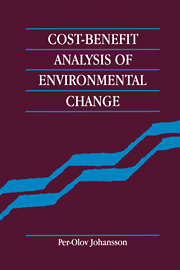Book contents
- Frontmatter
- Contents
- List of figures
- Preface
- 1 Introduction
- 2 Some basic concepts
- 3 Consumer surplus measures
- 4 Valuing public goods: practical methodologies
- 5 General equilibrium cost-benefit rules
- 6 Cost-benefit rules, national income accounts and sustainable development
- 7 Valuation and aggregation: intragenerational and intergenerational issues
- 8 Cost-benefit rules in a risky world
- 9 Valuing changes in access conditions, health risks and information
- 10 Empirical applications
- 11 Policy instruments and international environmental problems
- Notes
- References
- Index
1 - Introduction
Published online by Cambridge University Press: 15 January 2010
- Frontmatter
- Contents
- List of figures
- Preface
- 1 Introduction
- 2 Some basic concepts
- 3 Consumer surplus measures
- 4 Valuing public goods: practical methodologies
- 5 General equilibrium cost-benefit rules
- 6 Cost-benefit rules, national income accounts and sustainable development
- 7 Valuation and aggregation: intragenerational and intergenerational issues
- 8 Cost-benefit rules in a risky world
- 9 Valuing changes in access conditions, health risks and information
- 10 Empirical applications
- 11 Policy instruments and international environmental problems
- Notes
- References
- Index
Summary
Scope of the study
Most real-world policy changes create conflicts of interest. For example, if a forest which is used as a recreation area is cleared, those owning the forest will gain, while those visiting the area or those concerned about an endangered species living there will lose. Nevertheless, a decision must be taken whether or not to cut down the forest. The decision-maker must implicitly or explicitly transform all values to a single ‘dimension’ to compare them. Only then can he decide whether or not the value of the timber exceeds the value of the preserved forest. The economist's way of performing this transformation is to try to express all utility changes in monetary terms. This is the essence of social cost-benefit analysis. Once all benefits and costs have been expressed in monetary units, the social profitability of the considered project can be assessed.
The beginnings of cost-benefit analysis date back over a century to the work of Jules Dupuit, who was concerned with the benefits and costs of constructing a bridge; Dupuit's famous paper ‘On the utility of public works’ was published in 1844. In particular, Dupuit introduced the concept of the consumer surplus, i.e. the fact that benefits are measured by an area under a demand curve, not by what is actually paid. The next major contribution to cost-benefit analysis seems to have appeared almost one hundred years later.
- Type
- Chapter
- Information
- Cost-Benefit Analysis of Environmental Change , pp. 1 - 6Publisher: Cambridge University PressPrint publication year: 1993



